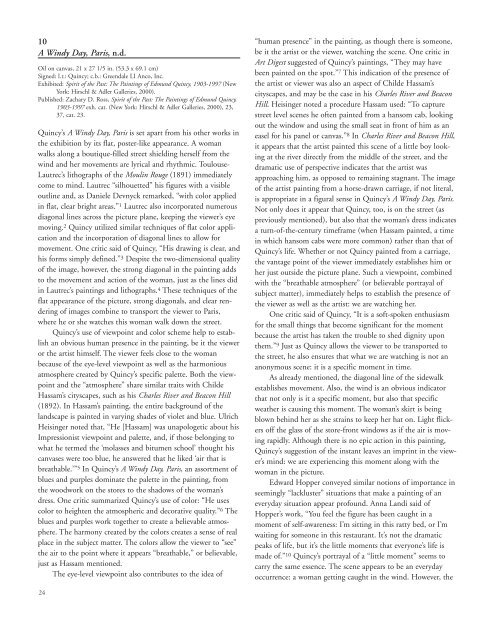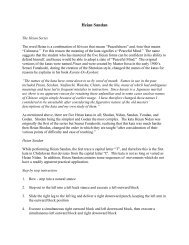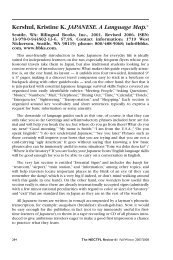selected paintings - Dickinson College
selected paintings - Dickinson College
selected paintings - Dickinson College
You also want an ePaper? Increase the reach of your titles
YUMPU automatically turns print PDFs into web optimized ePapers that Google loves.
10<br />
A Windy Day, Paris, n.d.<br />
Oil on canvas, 21 x 27 1/5 in. (53.3 x 69.1 cm)<br />
Signed: l.r.: Quincy; c.b.: Greendale LI Anco, Inc.<br />
Exhibited: Spirit of the Past: The Paintings of Edmund Quincy, 1903-1997 (New<br />
York: Hirschl & Adler Galleries, 2000).<br />
Published: Zachary D. Ross, Spirit of the Past: The Paintings of Edmund Quincy,<br />
1903-1997 exh. cat. (New York: Hirschl & Adler Galleries, 2000), 23,<br />
37, cat. 23.<br />
Quincy’s A Windy Day, Paris is set apart from his other works in<br />
the exhibition by its flat, poster-like appearance. A woman<br />
walks along a boutique-filled street shielding herself from the<br />
wind and her movements are lyrical and rhythmic. Toulouse-<br />
Lautrec’s lithographs of the Moulin Rouge (1891) immediately<br />
come to mind. Lautrec “silhouetted” his figures with a visible<br />
outline and, as Daniele Devnyck remarked, “with color applied<br />
in flat, clear bright areas.” 1 Lautrec also incorporated numerous<br />
diagonal lines across the picture plane, keeping the viewer’s eye<br />
moving. 2 Quincy utilized similar techniques of flat color application<br />
and the incorporation of diagonal lines to allow for<br />
movement. One critic said of Quincy, “His drawing is clear, and<br />
his forms simply defined.” 3 Despite the two-dimensional quality<br />
of the image, however, the strong diagonal in the painting adds<br />
to the movement and action of the woman, just as the lines did<br />
in Lautrec’s <strong>paintings</strong> and lithographs. 4 These techniques of the<br />
flat appearance of the picture, strong diagonals, and clear rendering<br />
of images combine to transport the viewer to Paris,<br />
where he or she watches this woman walk down the street.<br />
Quincy’s use of viewpoint and color scheme help to establish<br />
an obvious human presence in the painting, be it the viewer<br />
or the artist himself. The viewer feels close to the woman<br />
because of the eye-level viewpoint as well as the harmonious<br />
atmosphere created by Quincy’s specific palette. Both the viewpoint<br />
and the “atmosphere” share similar traits with Childe<br />
Hassam’s cityscapes, such as his Charles River and Beacon Hill<br />
(1892). In Hassam’s painting, the entire background of the<br />
landscape is painted in varying shades of violet and blue. Ulrich<br />
Heisinger noted that, “He [Hassam] was unapologetic about his<br />
Impressionist viewpoint and palette, and, if those belonging to<br />
what he termed the ‘molasses and bitumen school’ thought his<br />
canvases were too blue, he answered that he liked ‘air that is<br />
breathable.’” 5 In Quincy’s A Windy Day, Paris, an assortment of<br />
blues and purples dominate the palette in the painting, from<br />
the woodwork on the stores to the shadows of the woman’s<br />
dress. One critic summarized Quincy’s use of color: “He uses<br />
color to heighten the atmospheric and decorative quality.” 6 The<br />
blues and purples work together to create a believable atmosphere.<br />
The harmony created by the colors creates a sense of real<br />
place in the subject matter. The colors allow the viewer to “see”<br />
the air to the point where it appears “breathable,” or believable,<br />
just as Hassam mentioned.<br />
The eye-level viewpoint also contributes to the idea of<br />
24<br />
“human presence” in the painting, as though there is someone,<br />
be it the artist or the viewer, watching the scene. One critic in<br />
Art Digest suggested of Quincy’s <strong>paintings</strong>, “They may have<br />
been painted on the spot.” 7 This indication of the presence of<br />
the artist or viewer was also an aspect of Childe Hassam’s<br />
cityscapes, and may be the case in his Charles River and Beacon<br />
Hill. Heisinger noted a procedure Hassam used: “To capture<br />
street level scenes he often painted from a hansom cab, looking<br />
out the window and using the small seat in front of him as an<br />
easel for his panel or canvas.” 8 In Charles River and Beacon Hill,<br />
it appears that the artist painted this scene of a little boy looking<br />
at the river directly from the middle of the street, and the<br />
dramatic use of perspective indicates that the artist was<br />
approaching him, as opposed to remaining stagnant. The image<br />
of the artist painting from a horse-drawn carriage, if not literal,<br />
is appropriate in a figural sense in Quincy’s A Windy Day, Paris.<br />
Not only does it appear that Quincy, too, is on the street (as<br />
previously mentioned), but also that the woman’s dress indicates<br />
a turn-of-the-century timeframe (when Hassam painted, a time<br />
in which hansom cabs were more common) rather than that of<br />
Quincy’s life. Whether or not Quincy painted from a carriage,<br />
the vantage point of the viewer immediately establishes him or<br />
her just outside the picture plane. Such a viewpoint, combined<br />
with the “breathable atmosphere” (or believable portrayal of<br />
subject matter), immediately helps to establish the presence of<br />
the viewer as well as the artist: we are watching her.<br />
One critic said of Quincy, “It is a soft-spoken enthusiasm<br />
for the small things that become significant for the moment<br />
because the artist has taken the trouble to shed dignity upon<br />
them.” 9 Just as Quincy allows the viewer to be transported to<br />
the street, he also ensures that what we are watching is not an<br />
anonymous scene: it is a specific moment in time.<br />
As already mentioned, the diagonal line of the sidewalk<br />
establishes movement. Also, the wind is an obvious indicator<br />
that not only is it a specific moment, but also that specific<br />
weather is causing this moment. The woman’s skirt is being<br />
blown behind her as she strains to keep her hat on. Light flickers<br />
off the glass of the store-front windows as if the air is moving<br />
rapidly. Although there is no epic action in this painting,<br />
Quincy’s suggestion of the instant leaves an imprint in the viewer’s<br />
mind: we are experiencing this moment along with the<br />
woman in the picture.<br />
Edward Hopper conveyed similar notions of importance in<br />
seemingly “lackluster” situations that make a painting of an<br />
everyday situation appear profound. Anna Landi said of<br />
Hopper’s work, “You feel the figure has been caught in a<br />
moment of self-awareness: I’m sitting in this ratty bed, or I’m<br />
waiting for someone in this restaurant. It’s not the dramatic<br />
peaks of life, but it’s the little moments that everyone’s life is<br />
made of.” 10 Quincy’s portrayal of a “little moment” seems to<br />
carry the same essence. The scene appears to be an everyday<br />
occurrence: a woman getting caught in the wind. However, the






